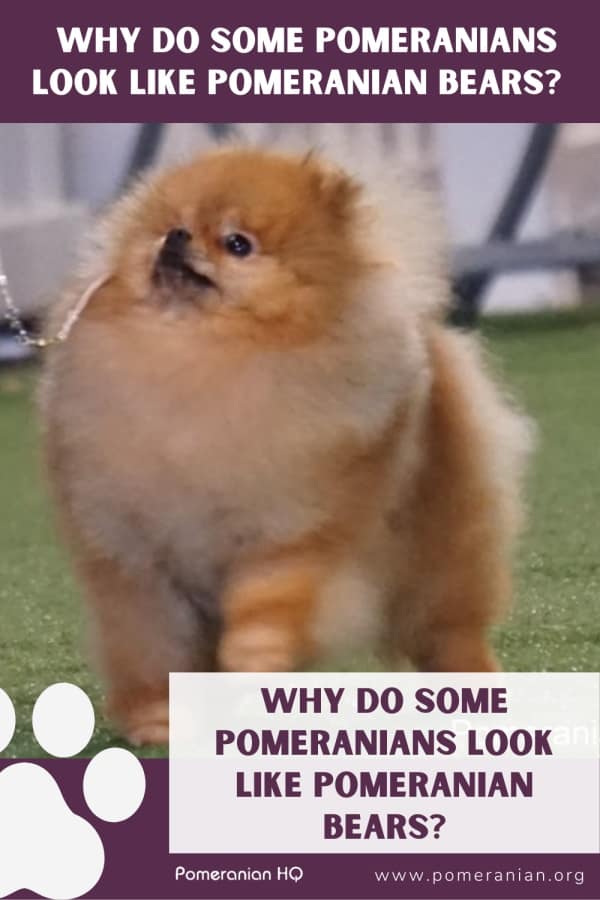Last Updated on 03/11/2023 by Dochlaggie. Post first published on November 7, 2022.
The truth is this – there are no breed differences between a Pomeranian and a teddy bear Pomeranian. Officially, there is only one Pomeranian dog, and this is the Pomeranian. Teddy bear, teacup, and fox-faced are unofficial terms for this toy breed.
People may call some Pomeranians who have certain characteristics teddy bear Pomeranians. This unofficial term “teddy bear Pomeranian” refers to how a Pomeranian looks, particularly his fur head and legs.
All Pomeranians are individuals; no two Pomeranians look the same. There is a big difference between Pomeranians bred by preservation breeders and people who do not show their dogs. I want to explain the correct information about the Pomeranian teddy bear dog.
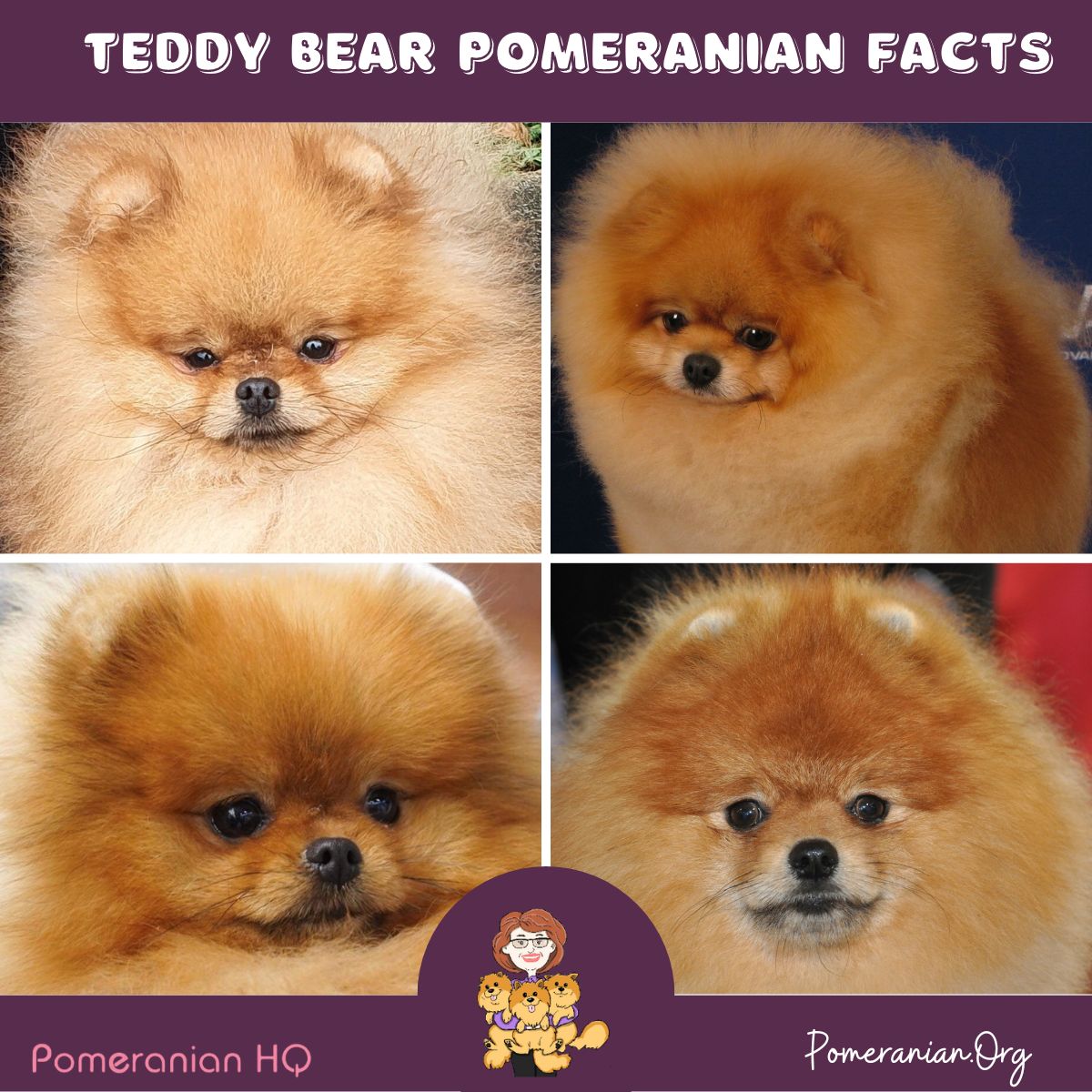
Teddy Bear Pomeranian Facts
- There is no dog breed called a teddy bear Pomeranian.
- Pomeranian dogs with dense and correct coats are often said to resemble a “teddy bear.”
- These types of Pom dogs do not suffer any additional health issues.
- A Pomeranian who resembles a ‘teddy bear ” is not at any additional risk of coat issues.
- Grooming can help your Pomeranian look neat, but a groomer will struggle to obtain the “teddy bear” look on a Pomeranian without a sufficiently dense coat.
- Potty Training is often difficult for owners of most small dog breeds.
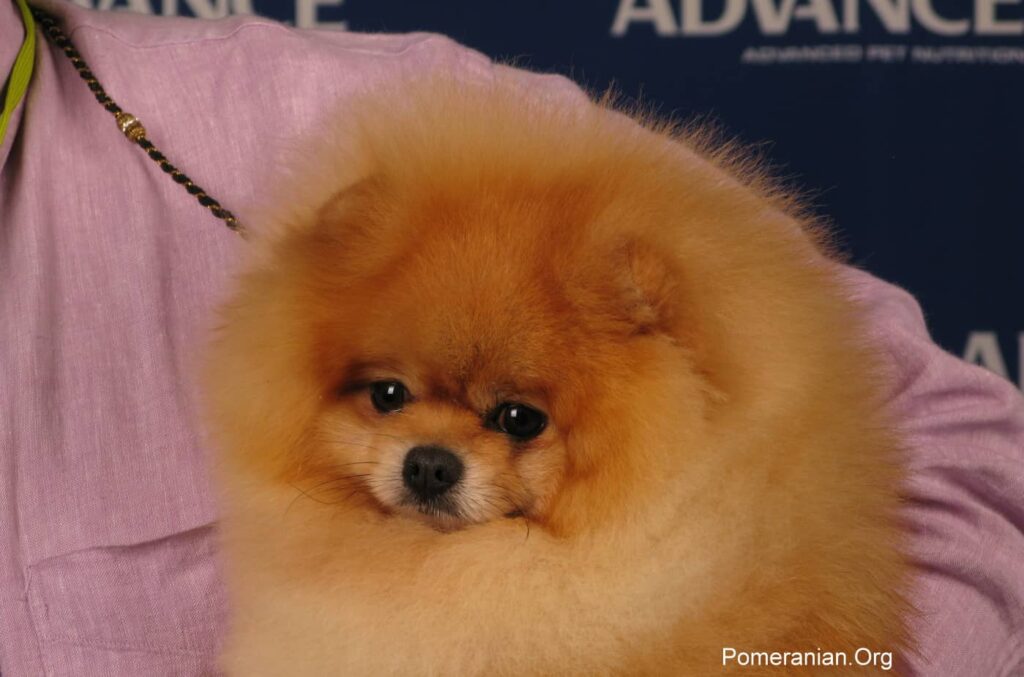
Why Do Some Pomeranians Look Like Pomeranian Bears?
It’s all a matter of genetics combined with good grooming. In England in the mid-18th century, breeding began with serious working dogs. The goal was to produce a new breed that was a wonderful companion eventually.
Queen Victoria was an early Pomeranian breeder. Preservation breeders spent decades in selective breeding, resulting in the newly-named Pomeranian.
During the late 1880s, the Pomeranian dog arrived in the United States and was accepted shortly thereafter by the American Kennel Club.
American breeders imported Pomeranians, mainly from England, for further breeding and to appear in shows.
They also started breeding Pomeranians with short snouts, dense, thick legs, and face fur. This dense fur gave these small dogs the appearance of having thicker legs or sometimes had people assuming their bones were heavier than the norm.
However, this isn’t the truth. The dense fur on the head makes the bear face Pomeranian appear to have tiny ears, a short nose, and cheeks appear fuller.
If a Pomeranian puppy has plenty of dense hair on his head, it may appear as though his head resembles a teddy bear shape.
If you need help, run your fingers over his skull to figure out the exact shape. In most cases, the measure from the dog’s nose to the stop and then the stop to the back of his head will be 1:2.
Those people were breeding within the Pomeranian breed standard, which meant each of their Pomeranians had correct body and head proportions.
Show breeders spend countless hours trimming and grooming their Pomeranians before every show, and their neat, trimmed coat contributes to their “Pomeranian that looks like a teddy bear” appearance.
How To Buy Teddy Bear Face Pomeranian Dogs
If you’re trying to locate small-size teddy bear Pom breeders, the best thing to do is contact a breeder who is actively showing their Pom dogs.
Ask if they have Pomeranian puppies that look like teddy bear Poms or teddy bear Pomeranians for sale.
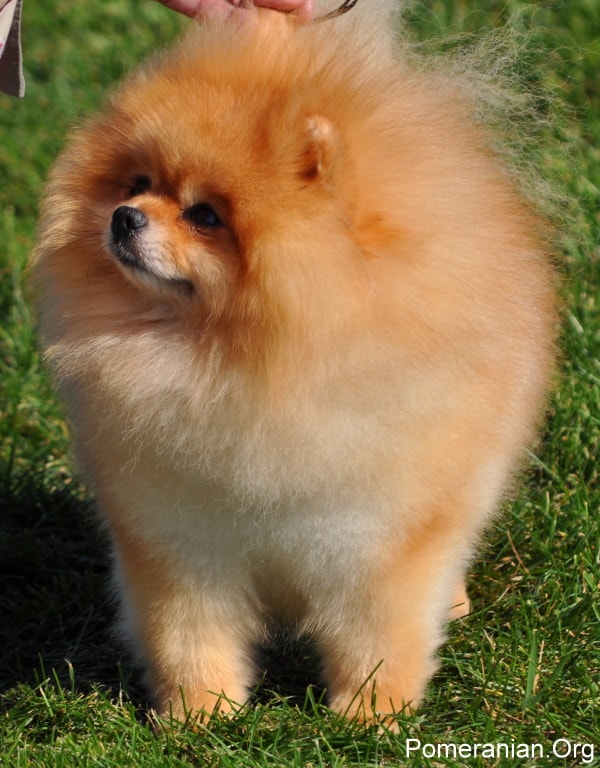
Grooming Teddy Bear Pomeranians
Now you’re the proud owner of a bear-type Pomeranian, and please don’t forget grooming and trimming play an important part in retaining the teddy bear Pom look.
A different reason why a Pom can be called a teddy bear is that it doesn’t have any connection with the structure of its face. Instead, it’s a nickname describing the breed after his coat has been trimmed. For example, shaving him to resemble Boo the Pomeranian is a specific example. (Boo lost his life in 2017).
As previously mentioned in the grooming and shaving Pomeranian sections, it’s vital that trimming is carried out gently and with plenty of care about the end result. Hundreds of years have been spent ensuring the perfection of the Pomeranian’s thick double coat.
The outer layer of hair (aka guard hairs) that are full and longer in length. The inner layer is short and dense.
The Arctic Spitz dog, an ancestor of the Pom, possessed this kind of fur, just like the Pom. Careful consideration should be given before trimming the outer coat to achieve a teddy bear look.
If one trims down the fur coat into the inner layer, there is a very good chance that the coat will never again be able to grow as it was meant to. Grooming in this way is essentially a lifelong commitment.
Now, with this said, guard hairs can be trimmed and touched up. They can be snipped back to create balance and shape to give this dog the Teddy Bear look. But this should be done carefully.
If too little is trimmed, you can always touch it up later. It will be too late if too much is taken off to try and achieve Teddy bear looks. And it can take a long time for the coat to grow back.
Another way that one may refer to these tiny dogs as Teddy Bear has nothing to do with facial structure. Rather, it is a nickname given to this breed when the coat is shaved down. Shaving to look like Boo the Pomeranian is an example of this.
As we discuss in detail in our Shaved Pomeranian and Grooming Section, trimming must be done carefully. Hundreds of years have gone into perfecting this breed’s thick double coat.
Nature calls out for the Pomeranian to have a double-layered fluffy coat. There is the inner layer, which is dense and short. There are also outer hairs (called guard hairs) that are long and full.
The Pom’s ancestors, the Arctic Spitz dog, had this type of fur, and so should the modern Pomeranian. Snipping off the top fur to create a Teddy Bear appearance must be considered.
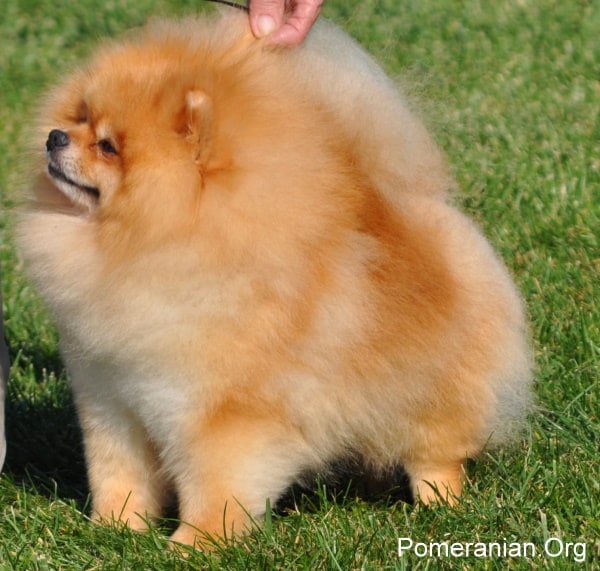
If one trims down into the inner layer, there is a very good chance that the coat will never again be able to grow as it was meant to. Grooming in this way is essentially a lifelong commitment.
Now, with this said, guard hairs can be trimmed and touched up. They can be snipped back to create balance and shape to give this dog the teddy bear look or cut.
But this should be done carefully. If too little is trimmed, you can always touch it up later. If too much is taken off to try and achieve the Teddy bear look, your Pomeranian may experience coat loss issues.
Download my grooming book and learn how to groom your Pomeranian yourself, or take your Pomeranian to an experienced Pomeranian groomer. If you know you can’t invest the necessary time to groom yourself, a professional Pomeranian groomer is the best choice.
Dog owners should invest in the correct grooming tools, even if they intend to use the service of a professional groomer. Essential grooming tools are a large, soft, slicker brush, a pin brush ( without rubber tips), and a quality dog comb with large teeth).
Will Taking my Pomeranian to the Groomer Give Him the Pomeranian Teddy Bear look?
In some cases, yes, and in others, no. This depends on the breed type quality of your dog and the experience and skills of your groomer. Bathing, drying, and trimming a fox face Pomeranian will never make this type of dog look like a bear-type Pomeranian.
Poms sourced from backyard breeders and puppy mills usually have very little chance of being turned into a Pomeranian teddy bear dog at the hands of any groomer.
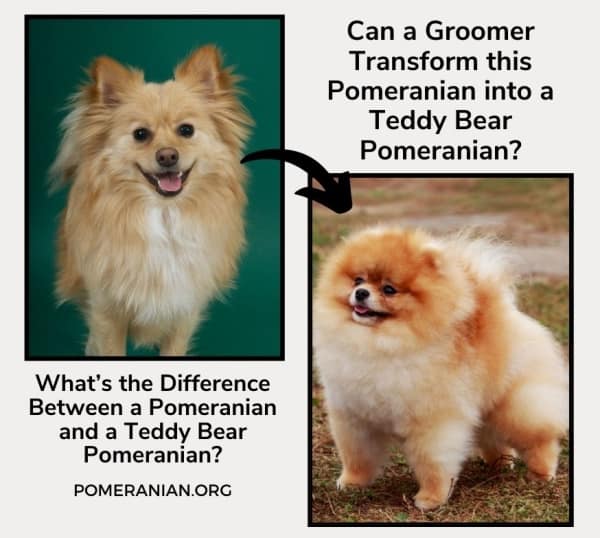
To avoid any disappointments, before leaving your dog with the groomer, discuss in detail your expectations and, if possible, provide a photo of what you would like your dog to look like when you return to collect him.
Myths About Bear-Type Pomeranians
There are numerous myths about Pomeranians; while many are fake, some people are willing to believe almost anything. Here, I’ll clarify myths and explain facts.
Teddy Bear Pomeranian Myth: Different breeds of Pomeranians can experience different problems.
Fact: Different types of Pomeranian breeds don’t exist!
However, Pomeranians may have different face types and features, hairstyles, and sizes that may get people assuming they’re different dogs when they’re all simply Pomeranians.
Facts: Teddy bear-faced Pomeranians don’t experience more health issues than any other type of Pomeranian. The Pomeranian that looks like a teddy bear usually does not have a health concern because of a shorter snout.
Dogs who appear to be bear-faced Pomeranian dogs don’t have the same breathing issues as in established brachycephalic breeds.
Pomeranian Fact: The Pomeranian breed can suffer from coat loss issues.
Teddy Bear Pomeranian Type Fact: A bear-type Pomeranian is no longer at risk from diseases mentioned in our Pomeranian health section than a fox-faced Pomeranian.
Teddy Bear Pomeranian Myth: Teddy bears possess a shorter body and, as a result, could experience other problems, some of which can be very serious. The original Pomeranian has been bred down from his medium to large-sized body to today’s toy dog.
Most toy dogs have a bigger chance of bone and joint troubles, such as patella luxation. While hip dysplasia issues seem a large dog breed issue.
Teddy Bear Face Pomeranian Myth: Perhaps the worst myth is about a disease known as Chiari Malformation (CM), which causes Syringomyelia (SM) and is beginning to prevail in Pomeranians. It’s an extremely crippling condition whereby a dog’s skull isn’t big enough to accommodate the brain.
The back of the brain (cerebellum) gets forced downwards into a hole at the rear of the head leading to the spinal cord. The dog experiences such pain that his whole body becomes contorted and often causes paralysis.
Rest assured, Pomeranian lovers, this is a relatively rare health issue. It is only very occasionally diagnosed in Pomeranians and has nothing to do with the density of a Pomeranian dog’s fur or his looks.
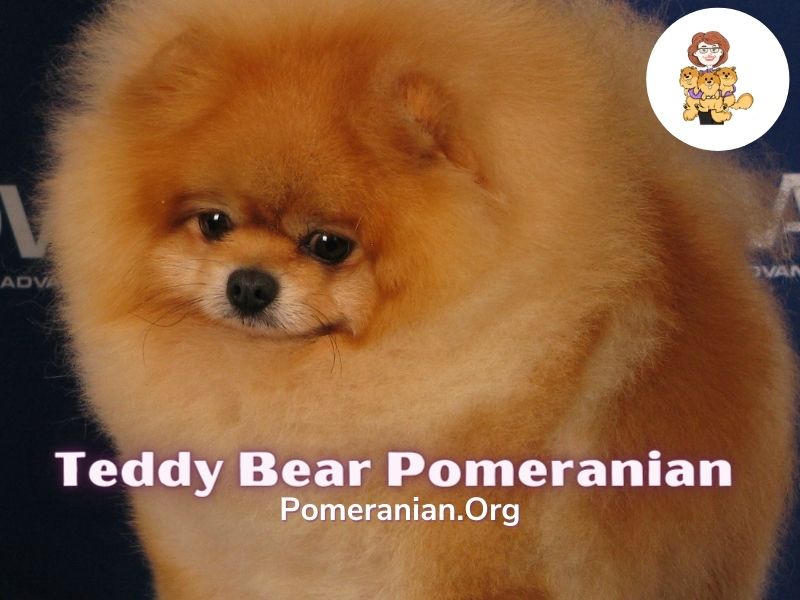
Final Thoughts on Pomeranian Bear Dogs
While all toy dog breeds are captivating with their charm and distinct personalities, the “Teddy Bear Pomeranian” and the traditional Pomeranian dog have differences that cater to various preferences.
Whether drawn to the teddy bear-like appearance or the classic fox-faced look, both offer companionship and the trademark Pomeranian vivacity.
Ultimately, the choice comes from personal aesthetics and what you want in a furry friend. Regardless of the option, a Pomeranian, in any form, promises a lifetime of joy and loyalty.
Hopefully, this article has cleared up all your questions about Pomeranian puppies that look like teddy bears and the cuddly appearance of the teddy bear Pom.
This website is a trusted Pomeranian blog. It was started decades ago by Pomeranian breed expert Denise Leo. Read her “About Me” page for information on the author’s Pomeranian breed qualifications and feel safe knowing that a Pomeranian expert has written all the information on this site.
The internet is a great tool for information, but unfortunately, people without qualifications can quickly set up a website and start posting incorrect material on just about any subject.
The Pomeranian dog is not immune to these “get rich quick” bloggers who steal information from this site, reword it, and quickly post it on their own sites.
These people usually have never owned a Pomeranian and have never been involved in showing or breeding Pomeranians, and because English does not seem to be their first language, the intent of the information is quickly lost in the rewording.
You should now know how to buy teddy bear Pomeranian dogs and how to care for bear-type Pomeranian puppies.
Copyright Pomeranian.org. All Rights Reserved.
References and Further Reading:
[1] Official Standard of the Pomeranian (AKC). American Kennel Club, 2011.
[2] English Kennel Club Pomeranian Breed Standard, 2017.
[3] Denise Leo, The Pomeranian Handbook.
[4] Milo G. Denlinger “The Complete Pomeranian.”
[5] Kimbering Pomeranians “1891-1991”.
[6] William Taplin’s “The Sportsman’s Cabinet.”
[7] E. Parker “The Popular Pomeranian.”
[8] Lilla Ives “Show Pomeranians.”
The Pomeranian Handbook
